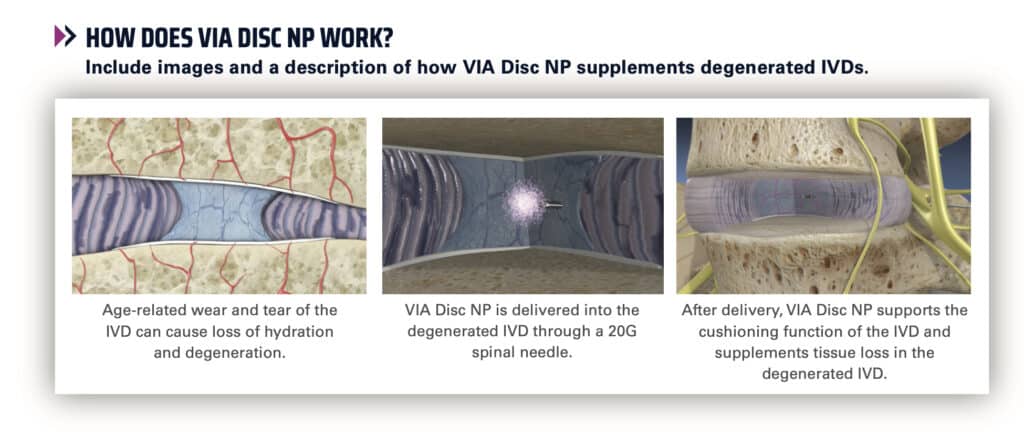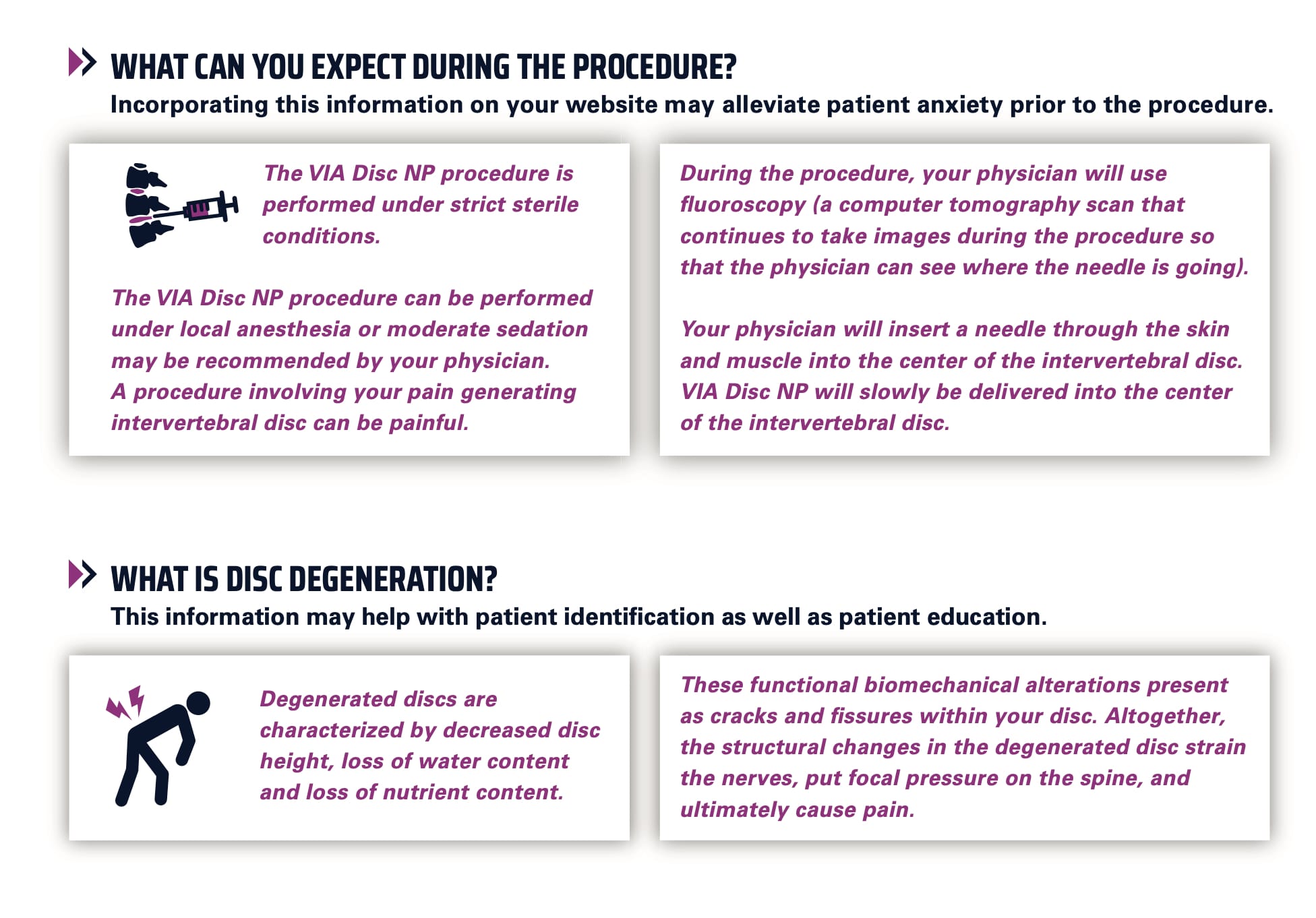ViaDisc Procedure
Do you suffer with lower back pain? The Southeastern Spine is always one step ahead in ways to help you with the latest technologies and procedures
One of the most common causes of chronic low back pain is degeneration of the lumbar intervertebral discs, better known as degenerative disc disease. DDD is age-related wear & tear of the discs can cause loss of water from within the disc causing dehydration and degeneration.
Until now there is no way to reverse degenerative discs. Once the damage sets in, it is permanent.
But now there is VIA Disc!
The Southeastern Spine Institute now offers this cutting-edge therapy as a non-surgical treatment option for patients suffering from chronic lower back pain resulting from degenerative disc disease. The revolutionary ViaDisc procedure can not only relieve your pain, but can reverse the damage and repair the discs from the inside.
The Viadisc procedure is a non-surgical, injectable ALLOGRAPT that utilizes allogeneic tissue and micronized disc material to repair degenerative discs.
Different from stem cell therapy where the hope is the cell will transform into useful cells for healing, allograft consists of tissue that has been obtained from healthy donors and then programmed to mature into a particular type of cell line that will repair a specific type of damage, so allograft is specialized for a specific task.
ViaDisc is a proven therapy that has been shown in clinical trials to repair damage to degenerative discs and provide significant pain relief and improved function.
Not all degenerated discs are immediately painful, however once a disc starts to degenerate, it can develop cracks and tears which will make it susceptible to injury later on. If left untreated degenerative disc disease can develop and lead to other painful conditions such as osteoarthritis, scoliosis, spinal stenosis, spondylolisthesis, and spondylolysis. Taking action and seeking treatment is essential to reduce pain and improve overall function
How Does it Work?
VIA Disc is injectable therapy that delivers allogeneic disc material inside the damaged disc that tricks the disc into healing and repairing itself. Using a proprietary cell line and preparation system, the graft is injected through a 22g needle into the damaged disc. Over the course of several weeks after the injection, the graft will begin to supplement the disc, causing it to regenerate and repair.
How is an Allograft Differ from Stem Cell Therapy?
Traditionally, during stem cell therapy, a doctor will obtain a large sample of tissue from the patient (i.e. bone marrow or adipose tissue), put it through a centrifuge to isolate stem cells, and then inject them back into the patient with the belief that these cells will miraculously know exactly where to go, what type of cell to become and what to do.
However, these cells can differentiate into anything ranging from cartilage and bone to muscle or just plain scar tissue. Without the proper genetic pre-programming, these stem cells can turn into any number of different cell types with zero guarantee that they will even know that there is damage to repair, let alone know where it it or how to actually repair it.
An Allograft, on the other hand, consists of tissue that has been obtained from healthy donors, thoroughly screened for any abnormalities, and then programmed to mature into a particular type of cell line that will repair a specific type of damage. Each allograft is specialized for a specific task.
How Many Treatments Will I Need?
In the VAST Trial, patients treated with ViaDisc only required ONE TREATMENT. So far, these patients have been followed out to 24-months with excellent results. Their progress will continue to be monitored as time goes on and their progress will continue to be reported.
When Will I Feel Better?
It may take several weeks before the effects are noticeable.


 Not all degenerated discs are immediately painful, however once a disc starts to degenerate, it can develop cracks and tears which will make it susceptible to injury later on. If left untreated degenerative disc disease can develop and lead to other painful conditions such as osteoarthritis, scoliosis,
Not all degenerated discs are immediately painful, however once a disc starts to degenerate, it can develop cracks and tears which will make it susceptible to injury later on. If left untreated degenerative disc disease can develop and lead to other painful conditions such as osteoarthritis, scoliosis,